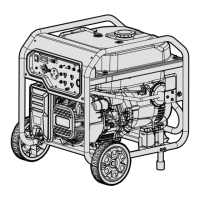MAINTENANCE
BATTERY MAINTENANCE/STORAGE
The battery will receive charge when the engine is running. Remember to run the generator once a month for 20-30
minutes to charge the battery. A charged battery will allow you to start the generator using the electric start switch
during your next time of need. If the battery is out of charge, you may start the generator using the recoil starter. If
the generator is not used for a long period, it is recommended to disconnect the quick-connector from the battery
to protect it from losing charge.
TIP: You can also connect the battery to an automatic trickle charger to keep the battery charged. If using a trickle-
charger, charge the battery at room temperature.
Lithium-ion batteries can be damaged or suffer a shortened lifespan if they are charged in very cold temperatures
(below freezing). If you expect to store the generator in temperatures below 25°F (-5°C), we recommend removing
the battery from the generator and storing it indoors. If using the generator in temperatures below 25°F (-5°C), we
recommend running the generator for at least 15 minutes with the battery removed, or the quick-connector cable
disconnected and covered with the rubber sheath, and then connecting the battery. This will allow the area around
the generator to warm up, and will greatly reduce the chance of damage to the battery.
35
To reinstall/replace the battery:
1. Unhook the battery strap from the engine frame. Remove the battery and disconnect the quick-connector.
2. Replace with an identical new battery (part no. DF8000X-065).
3. Connect the new battery by connecting the two ends of the quick connector together.
4. Secure the battery to the generator frame using the battery strap.
NOTE: Always recycle used batteries in accordance with local laws and regulations. Contact your local solid waste
collection site or recycling facility to obtain information on local recycling processes.
WARNING! It is best to store the battery indoors at room temperature. Do not store your battery outside in
the winter, where temperatures may go below 25°F (-5°C), or in any location where temperatures may exceed
104°F (40°C), such as in direct sunlight or inside a vehicle or metal building during the summer.

